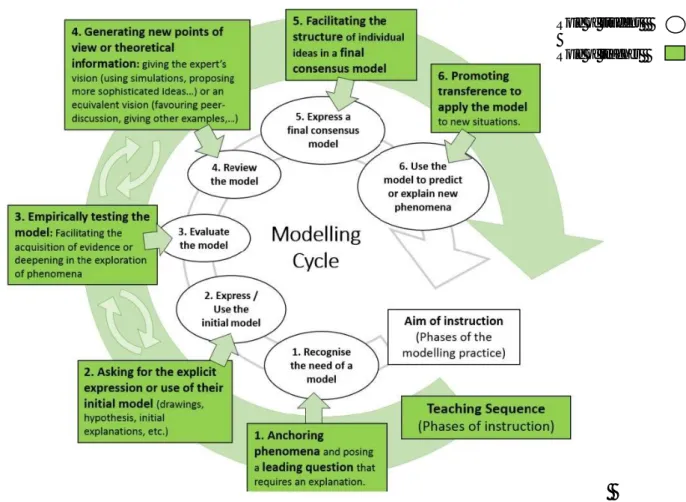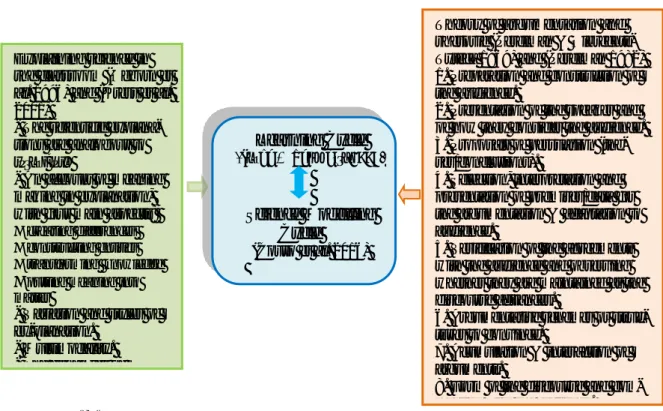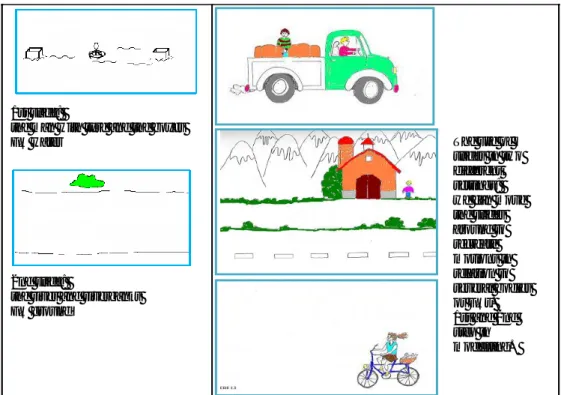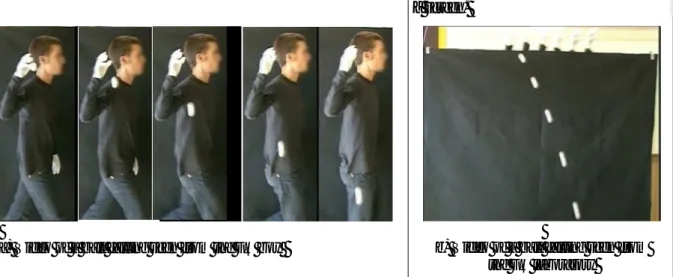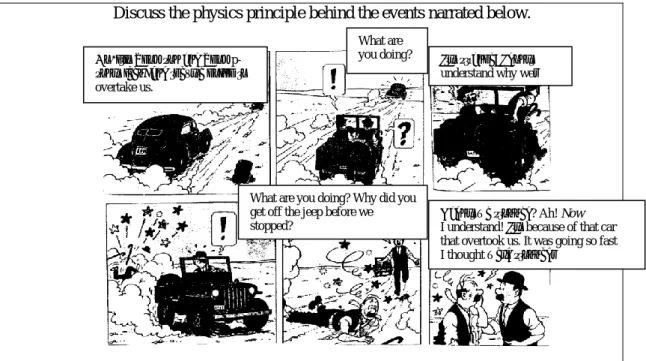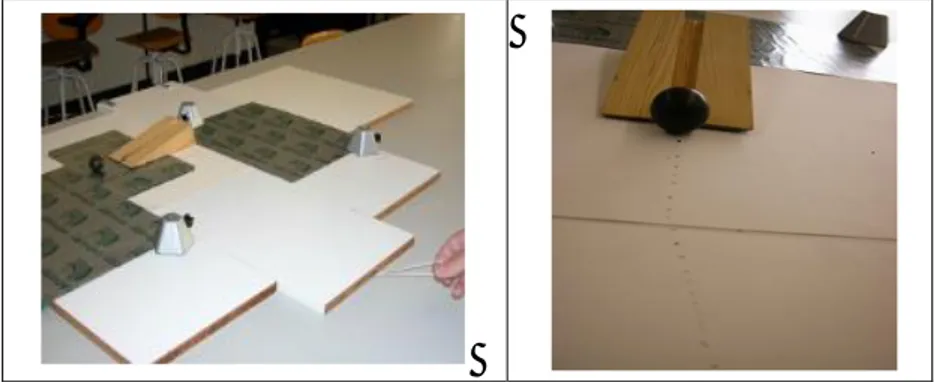PAPER • OPEN ACCESS
A proposed sequence of activities inspired by Galileo to exercise
reasoning and modelling about motion and frames of reference
To cite this article: Marina Castells et al 2018 J. Phys.: Conf. Ser. 1076 012023A proposed sequence of activities inspired by Galileo to
exercise reasoning and modelling about motion and frames
of reference
Marina Castells, Aikaterini Konstaninidou, Àngela Garcia-Lladó
Dep. Linguistic and Literary Education, and Didactics of Experimental Sciences and Mathematics Universitat de Barcelona, Catalonia, Spain
Abstrac. This paper presents a proposed teaching sequence by means of the description of teacher-mediated activities in a teaching sequence completed by primary and secondary educa-tion teacher trainees engaged in physics modelling. During the sequence, students solve a series of activities guided by the trainee teachers, whose discourse includes verbal and non-verbal communication and actions on or with physical objects, drawings, diagrams, graphs and other communicative resources. The students are guided through a process of knowledge build-ing that begins with physical phenomena and advances through several levels of abstraction. This paper illustrates the process by analysing the narrative of the teaching sequence and the detail of some of the activities with the role of teachers and students in the physics modelling process.
1. Introduction: background and proposal
Currently, there is a general consensus that science education has to develop a broad range of compe-tences in future citizens, including compecompe-tences in science and technology. School-leavers must be able to use theoretical models to interpret scientific facts and think critically about issues of science and technology and about scientific information as it appears in the media. Moreover, as individuals they must share values related to science and technology that help them contribute directly to solving socio-scientific problems or negotiate technological issues with scientific and technological knowledge, methods and argumentation skills.
Related to this general context of education, conceptual learning acquires new importance. Students enter the classroom confident that the knowledge they already have can help them to interpret the world, but we know that part of this knowledge conflicts with scientific knowledge; and because some students are reluctant to reconsider what they think they know, teachers must convince them of the value of finding ‘new ways of seeing’ the world. According to Ogborn (1996), teachers have to create a need for knowledge in their students (“Creating Differences”) that attracts them to new knowledge and helps them accept it. If the learning process involves many changes in the ‘ways of seeing the world’ (Leach & Scott 1995) teachers must be ready to guide students through these, using as their point of departure real phenomena or ‘experimental facts’ or activities presented in the classroom through dialogical discourse. And this discourse will be multimodal, making use of verbal communi-cation, gestures, actions, drawings or diagrams and videos, among other resources, as well as argu-ments given in explanations or in argumentation with the students.
This paper considers the role of the teacher as a guide in the abstraction process that students must complete in order to build scientific models (Gutiérrez 2001). The aim of our study is to apply
a proposed sequence in several groups of students and to observe through video recording how it works. In the implementation, the students are guided through a process of knowledge building that begins with physical phenomena and advances through several levels of abstraction. This paper illus-trates the process by analysing the narrative of the teaching sequence and the detail of some activities and some emerging problems, with the role of teachers and students in the physics modelling process.
The teaching topic in all the problems will be Galilean relativity (Castells et al. 1996, Castells 1997, Saltiel & Malgrange 1980, Viennot 1996).
2. Theoretical framework
Our study is underpinned by three theoretical bases: the use of multimodal resources to make class-room explanations convincing (Ogborn et al. 1996, Kress et al. 2001); Perelman’s rhetorical model of argumentation for justifying and convincing (Perelman & Olbrecht-Tyteca 1969, Perelman 1982); and the Science Modelling Cycle (Couso & Garrido 2016). These are described in detail below.
Explaining science in the classroom and multimodal resources (Ogborn et al. 1996, Kress et al. 2001). According to this perspective, science classroom explanations are communicative activities that have to be understood in their broadest sense as knowledge-building activities. Scientific meaning is built by means of language in its verbal, visual and formal mathematical modes, and with other semi-otic instruments (e.g., gestural language and acts of communication based on or using objects from the physical world) that mediate the construction of new “explanatory entities” and models that help stu-dents think about and comprehend the real world or laboratory phenomena. The teacher uses various communicative resources to make their ‘stories’ convincing. (Màrquez et al. 2006, Clement 2008, Castells 2006).
The rhetorical and argumentative perspective (Perelman & Olbrechts-Tyteca 1969, Perelman 1982). This provides a very useful theory for understanding how teacher discourse uses rhetoric and argumentation. The theory consists of different discursive elements that contribute to the consistency of the discourse and its influence on a particular audience, or that provide the means by which to help convince this audience (Fagundez & Castells 2012, Castells et al. 2007).
Science Modelling Cycle (Couso & Gar-rido 2016). Science education experts have built models of learning cycles to describe science education within a constructivist para-digm comprising several steps in the students’ construction of knowledge (Fig. 1) (Jorba & Sanmartí 1997). These steps go from simple to complex and from concrete to abstract along two axes. More recently, various cycles re-sembling the learning cycle have been adapted to suit the construction of scientific models or modelling processes in science classrooms (Gutierrez 2001). One of these is the new Science Modelling Cycle (Hernández et al. 2015, Couso & Garrido 2016), in which the steps in the students’ learning cycle are differ-entiated from the teacher’s instructional cycle
Fig. 2. Science Modelling Cycle (Couso & Garrido 2016)
How do these three theoretical bases contribute to our study? Ogborn et al. (1996) and Kress et al. (2001) understand that teachers’ multimodal discourse in the science classroom is “built like a story” (Ogborn et al. 1996, p. 86), complete with protagonists and a plot, which helps us consider the steps of the Science Modelling Cycle as a sequence; and Perelman’s rhetorical model of argumentation pro-vides a very useful way to understand and evaluate the convincing character of the teachers’ multi-modal and argumentative discourse in the teaching-learning process. In the next page (Figure 3) we summarize the main aspects of the theoretical framework we used to complete the study.
3. Methodology
The focus of the research is a number of teacher-mediated activities in which the teacher uses a generally multimodal and dialogical teaching style to explain subject matter to a group-class (Scott et al. 2006). The teacher does this with hand-made or mental experiments, or demonstrations with actions on physical objects.
Role of student Role of teacher
However, we have organized the second part of this paper as a presentation of the narrative of the teaching sequence about Galilean relativity, in which some of the teaching are characterized in terms of the steps in the Science Modelling Cycle that they help the class to complete and also their degree of abstraction.
This methodology was chosen in line with our three theoretical bases, summarized above, which all contribute to our understanding of what occurs in the classroom in the teachers’ instructional role. Bearing this in mind, the paper has actually been written as the case study of the activities (some are problems) in the teaching sequence rather than of the teachers themselves.
The classes take place in a physics laboratory and the experiments are generally performed by the teachers alone or with the support of the students. Our research is qualitative. The discourse of several trainee teachers is video-recorded during their multimodal intervention in physics classes.
The narrative of the teacher’s explanation and the illustration of the activities in the teaching sequence
Once they have a teaching topic, the teacher or teaching sequence designer will need to choose a fundamental and inclusive question to support that topic’s conceptual structure. This question, which we will call the ‘big question’, would be answered during the sequence or at its end.
In our particular sequence, the big question would be stated as follows: “Is motion absolute or rela-tive to other bodies or systems?” Such a question would help the students understand the main princi-ple of Galilean relativity, which is that ‘the motion of a body (system) is always relative to another body (system) and absolute motion does not exist and has no scientific meaning’. To answer the ques-tion, however, the students would need to consider two further questions: “What is motion?” and “What is a frame of reference?”
Although the question “What is motion?” is not very difficult to answer, the scientific principle be-hind it is counter-intuitive, making it less easy for students to accept. The question “What is a frame of reference?” is more complex, chiefly because frame of reference (FR) is a highly abstract notion in physics. Consequently, the students’ knowledge level will be important in determining which
ap-Fig. 3. Summary of our theoretical bases
Fig. 3. Summary of our theoretical bases
Explaining science in the classroom (Ogborn et
al. 1996) and (Kress et al.
2001)
- The scientific explana-tions are analogous to ‘stories’.
- An account of meaning making in explanation, with four main aspects: creating differences
constructing entities
transforming knowledge
putting meaning into matter
- Variation and styles of ex-planation.
- Multimodality. - The dynamics of
Learning Cycle
(Jorba & Sanmartí 1997)
Science Modelling Cycle
(Couso et al. 2016)
Learning Cycle
Theory of argumentation and rhetoric (Perelman & Olbrechts-Tyteca 1969) and (Perelman 1982) 1. Preparation and construction of
the audience.
2. Presentation of the speaker and of how they consider the audience. 3. Proposals of persuasion (the-ses/conclusions).
4. Selection, interpretation and presentation of premises/data for the argumentation & adaptation to audience.
5. Verification of the agreements with the audience and observing whether they are maintained as the discourse advances.
6. Argumentative schemes or
struc-tures to convince.
7. Acumulation & interaction of arguments.
8. Form of the discourse and
proach best introduces the notion of FR in the classroom. For example, for students in primary and compulsory secondary education the notion of Mechanical System (MS) introduced by Giordano Bru-no (Tonnelat 1974) and Galileo may be more accessible than other approaches. In La Cena de le Ceneri (trans. The Ash Wednesday Supper) (1584), Bruno explains MS as “an ensemble of bodies animated with the same motion, but it is as if this motion in which they participate did not exist” and he also states that “it is impossible to recognize the motion of a Mechanical System from experiments made inside it” (Bruno, La Cena de le Ceneri, third dialogue). This also appears in Galileo’s Dia-logues.
In the case of trainee teachers in both the primary and upper secondary school classroom, the no-tion of FR put forwards by Bruno and Galileo could be expanded upon with Einstein’s treatment of FR, mainly based on certain texts that clearly illustrate the physicist’s notion of the concept (Jammer, with foreword of Einstein, 1970). A frame of reference is a space linked to an object of reference that we have to think of as being composed of infinite points radiating outwards from the object in all di-rections and that is without limits; the space moves with the motion of the object of reference and of-fers no resistance to the motion of any body. To describe motion it is also necessary to consider time, and we can imagine this space with a clock at every point. The notion of FR put forwards by Einstein is more abstract that Galileo’s but helps students understand certain aspects of the relativity of motion more effectively.
The section below describes the outline of the conceptual plot of the teaching sequence for trainee teachers and for students in secondary education, which is inspired by the history of relativity (Ton-nelat 1974).
Motion is the change in position of an object in relation to someone or something.
Objects that do not change position in relation to other objects constitute a reference frame. (Equivalently, we can say that all objects that move in the same way as others constitute a reference frame). The motion of any body is the same for all these objects.
The description of any motion is always relative to a reference frame.
The motion of an object can be described in relation to several reference frames. Motion chang-es when the FR changchang-es.
All objects that constitute an FR move in the same way in relation to another FR (in particular, the carrier and the carried object). Their mutual relations are such that this shared motion ap-pears not to exist. (This apap-pears in Galileo’s Dialogues).
The common motion of all the objects that constitute an FR is not lost when one of the objects is separated physically from the rest. (The motion that one object has by participating in the carry-ing motion is not lost when it becomes separated from the carrier.)
If FR A moves in relation to FR B, FR B moves in relation to A with the opposite motion. This means that, in relation to each other, the motions are the same but opposite.
We can interpret the motion of an object in relation to FR A as its motion in relation to FR B combined with the motion of FR B in relation to A.
Fragments from Galileo’s Dialogues and Bruno’s La cena de le ceneri would be adapted to provide a context or the inspiration for the activities (problems) proposed in the teaching sequence.
The activities: relationship with the Science Modelling Cycle and their abstraction level
At first, the students are presented with some qualitative activities (problems) designed to explore the students’ conceptions about Galilean relativity, the first of which is the problem of ‘the man in the river’, which poses two questions (activities 1 and 2).
Activity 1. The man in the river.
Imagine you are drifting down a river on a tyre. Ahead of you, a few metres downstream, there is a wooden box, floating on the water like you; and behind you, a few metres upstream, there is an-other box.
Question 1. If you go on drifting, without swimming, will the distance between you and each box change with time? Why or why not?
Question 2. Suppose the tyre gets flatter. Which of the two boxes will you reach first? Why?
The students solve this problem, first individually and in writing, and then together with their classmates, focusing on the ‘Why?’ and ‘Why not?’ questions and attempting to justify their answers. The teacher discusses the problem with the students, focusing on Question 1 to create the need for an initial scientific model.
Activity 1 would help the class complete the first step in the Science Modelling Cycle (teacher’s role: anchoring phenomena, meaning the initial situation or problem; students’ role: recognising the need for a model). Activity 1 also corresponds to what we could call a zero level of abstraction.
Activity 2. Dialogue about students answers to Question 2 of the initial model in Activity 1
Two student answers to Question 2 of Activity 1 are recorded below. Writing the answers to this ques-tion in groups is a way of completing the second step in the Science Modelling Cycle (teacher’s role: asking the students for the explicit expression or use of their initial model) and also the first level of abstraction in the learning cycle, insofar as the students need to use words in a coherent discourse.
S1: Even if the box upstream were nearer to us, swimming against the current requires a great ef-fort and it would be a waste of time, so even if the box downstream were further away, we would
reach it first, because the speed we acquire by swimming is complemented by the impulse of the current.
S2: I would go towards the box upstream because although I have to swim against the current, the
same current would bring the box towards me; in contrast, if I swam towards the box down-stream I would take longer to reach it because at the same time as I swam towards it, the box would be moving downstream by the force of the current.
Students can offer various solutions but in many cases their arguments will only be based on their intuition, meaning in this case a (non-scientific) model they initially brought into the classroom.
Activity 3. Motions from different FRs using slides as a visual resource
This is related to activities 1 and 2. Teachers may help the students to build the “correct” solution us-ing slides as a visual resource (Fig. 4).
With the help of a dialogical discussion about some of their answers to the initial problem and us-ing the slides resource with Activity 1, students express and use their initial model about motion and FR, which helps the class complete the second step in the Science Modelling Cycle (teacher’s role: predict the expression of the initial model; students’ role: express and use the initial model) and the first level of abstraction in the Learning Cycle (the use of words only).
The slides resource consists in drawing one or several bodies or a place on each slide, representing possible FRs, and then moving the slides in relation to each other, so that the different motions can be “seen” in relation to one another. This is an effective way to construct the concept of FR based on Bruno’s Mechanical System (Bruno 1584). (Note that slides offer a very adaptable resource in a variety of problem-solving activities related to Galilean relativity.)
1st slide:
the man with tyre and the boxes FR water
2nd slide:
the river and riverbanks FR ground The use of slides in two different settings: we can move the slides around to recreate motions in relation to several bodies or FRs. 1st and 2nd step in modelling.
Fig. 4. The transparency recourse in the study of the relativity of motion
Activity 4. The ball and the horseman
This is inspired by Galileo’s The ball that runs behind the horseman(Dialogues 1632, p. 156), which it adapts as a problem given to the students in written form (next page).
The activity helps the class complete the third step in the Science Modelling Cycle (teacher’s role: empirical testing of the model; students’ role: evaluating the initial model) or the fourth (teacher’s role: generating new points of view or theoretical information; students’ role: reviewing the model), as well as the first or second levels of abstraction in the Learning Cycle, respectively. The activity could be tailored to suit one particular step in the Science Modelling Cycle or in the abstraction process in one group class, and another step in another class. In fact, the steps are not characteristics of the activi-ties themselves but of the specific use of the activity in a group class.
The activity could also be used to help the class complete the fifth step in the Science Modelling Cycle (teacher’s role: facilitating the consensus model; students’ role: expressing a final consensus model) or the sixth (teacher’s role: promoting transference to apply the model; students’ role: using the model to predict or explain new phenomena).
A copy of the text from Galileo’s Dialogues could be given to students before or after they see the written problem.
One of the passages from Galileo’s Dialogues about the two Great Systems of the World (1632) is about a ball that “runs behind” two horsemen.
a) In this passage, the first time the two characters disagree is about what would happen to a ball dropped by a horseman. Salviati argues that when the ball hit the ground, instead of stopping there it would go on moving forwards like the horseman; and that if it wasn’t for the friction be-tween the ground and the ball, the ball would go on moving forwards at the same speed as the
horse. Simplicius argues that the ball would stop still and end up behind the horseman, unless he had thrown the ball hard in the direction he was going.
Who is right? Justify your answer using the model of Galilean relativity we made in class. b) The second time they disagree is when Salviati proposes that if one of the horsemen turned on
his horse, while riding at a constant speed, and threw a ball backwards, in the direction he had come from, when that ball hit the ground it would continue to travel forwards or else simply stop where it fell, but would only continue moving in the opposite direction to the horseman if he had thrown faster than the horse was galloping.
Is Salviati right? Justify your answer using the model of Galilean relativity we made in class. The idea could be adapted to make the task easier, as shown in Activity 5 below.
Activity 5. The ball and the boy
The students are given the same problem as in Activity 4 but Galileo’s horseman is replaced by the figure of one of their classmates. The result is that it becomes easier to see how the ball follows the boy.
A student walking across the classroom in a straight line drops an iron ball. What happens to the ball when it hits the ground? Does it move? If it does, how?
The problem is based on Galileo’s text and experimental activities 5 and 6 may help the students ac-cept the idea that the motion gained by one object by participating in the motion of the carrier is not lost when this object is separated from that carrier (first concept: motion is not lost when an object is separated from its carrier). This is a very important idea in the new model. Here, the resource is a simple experience and the use of analogous cases.
If we put the focus on the first concept, Activity 5 could help the class complete the first step in the Science Modelling Cycle (teacher’s role: anchoring phenomena, meaning the initial situation or prob-lem; students’ role: recognising the need for a model) and would also correspond to the zero level of abstraction. But it could also help them in the sixth step (teacher’s role: promoting transference to apply the model; students’ role: using the model to predict or explain new phenomena) (analogous to the activity using Galileo’s text).
Activity 6. The ball and the boy video-recorded
This activity is like Activity 5 using the video-recording resource (Fig. 5) from two different FRs. If the focus is on the first concept, Activity 6 could be used to help the class complete the second step in the Science Modelling Cycle (teacher’s role: predict the expression of the initial model; stu-dents’ role: express and use the initial model). But it could also be used for the sixth step (teacher’s role: promoting transference to apply the model; students’ role: using the model to predict or explain new phenomena) (analogous to Activity 4) and the first level of abstraction. The photograph of the trajectory seen from two FRs is like a representation of the trajectories of the ball seen from two dif-ferent FRs.
Situation: A boy walks across the laboratory and drops a ball. The same situation: A boy walks across the laboratory and drops a ball behind a screen.
a) Video of a ball falling seen from the FR boy b) Video of a ball falling seen from the FR laboratory
Fig. 5. Activity 6 with the video-recording of a ball being dropped by a boy walking across the
labora-tory, seen from two different FRs
Activity 7. Representing the motion from two FRs using event diagrams
Fig. 6 offers one way of illustrating the problem in activi-ties 1 and 2, The man in the river. Fig.7 and 8 (bank and water, respectively) are two event diagrams to be used to answer Question 2 in that problem and to help the student appreciate the two FRs.
The event diagram resource may be tailored to support study at a variety of specific or abstract levels, depending of the students’ age and class year, using realistic drawings, stick drawings or graphemes and symbols like dots and arrows.
Below (Figures 7 and 8), we offer an event diagrams for Question 2 with the FR riverbank or ground, and the FR water.
The event-diagram in a more abstract way is not included here, but it may be used specially with older students.
Fig. 7. Event diagram of Question 2
of the problem from the FR ground
Fig. 8. Event diagram of Question 2
of the problem from the FR water (river)
Fig. 6. The scenario of The man in
the river (initial situation in relation to the bank)
Fig. 6. The scenario of The man in
the river (initial situation in relation to the bank)
Activity 7 helps the class complete the fourth step (teacher’s role: generating new points of view or theoretical information; students’ role: reviewing the model) or the fifth (teacher’s role: facilitating the structure of individual ideas in a final consensus model; students’ role: expressing a final consensus model), as well as the second level of abstraction. The diagrams per se are abstract representations that help the students construct the model of Galilean relativity. This resource is inexpensive and easy to use, and very useful for helping students “see” motion from different FRs.
Other activities that use new resources Activity 8. Tintin and relative speed
This activity 8 uses the resource of a comic strip and may correspond to the sixth step of the use of the model constructed to predict or explain new phenomena (Figure 9).
Fig. 9. Activity 8. Tintin and relative speed. The comic as a resource to model relative speed
Activity 9. Recording trajectories with sheets of white paper and carbon paper
This activity can help the class complete the fourth, fifth or sixth steps, depending how it is used by the teacher. The new model is completed by adding the trajectories collected as convincing “proof” of the idea of the relativity of trajectories to the FRs, which is part of the scientific model being con-structed.
Like Galileo, the teacher use analogies, asking the students to think of a rolling ball on the bed of a railway freight car, conveyor belt or other such surface characterized by uniform motion in relation to the ground. We propose an experimental arrangement, analogous to the situation described, using as resources sheets of white paper and carbon paper mounted on wooden boards and representing the FR train and the FR ground.
This activity reinforces the concept of the relativity of the trajectories to the FR using the r e-source of collecting trajectories (here, using moveable wooden boards and sheets of white paper and
Discuss the physics principle behind the events narrated below.
No, it’s Thomson and Thomp-son’s jeep; and they’re going to overtake us.
No, it’s Thomson and Thomp-son’s jeep; and they’re going to overtake us.
It’s strange: I don’t understand why we… It’s strange: I don’t understand why we… What are
you doing? What are you doing?
What are you doing? Why did you get off the jeep before we stopped?
What are you doing? Why did you get off the jeep before we stopped?
Hadn’t we stopped? Ah! Now I understand! It’s because of that car that overtook us. It was going so fast I thought we’d stopped…
Hadn’t we stopped? Ah! Now I understand! It’s because of that car that overtook us. It was going so fast I thought we’d stopped…
carbon paper). The activity helps the class complete the fifth and sixth steps in the Science Mode l-ling Cycle. The trajectories and the arrows on them contribute to the third level of abstraction in the Learning Cycle.
Fig. 10. Recording trajectories using sheets of white paper and carbon paper
4. Final discussion
The activities proposed and inspired mainly by the history of science, specifically by the Dialogues of Galileo and implemented by several teachers support the learning about the main ideas and concepts of the scientific model of motion. The activities may be used at a lower or higher level of abstraction depending on the aims of the educational levels (secondary education or teacher trainees in primary or secondary science education). The problem we need to address is how teacher education courses should be redesigned if we consider the didactical meaning of the Science Modelling Cycle or the Learning Cycle, as well as the need to include the abstraction process in the construction of the scien-tific model.
Only some of the many possible activities are proposed here and our aim has been to give some idea of the approaches that can be adopted and of the simple and inexpensive resources that can help pre-service science education teachers support the construction of scientific models in the classroom.
The study also shows that the subject history of science can provide a highly appropriate context for inspiring instructional activities that favour science knowledge transfer.
Acknowledgements
The research was supported by ARCE 2015-UB to GRIEC-UB, and by the Spanish EDU2013-47599-C2-2-P (Coord. Mercè Garcia-Milà) and the Catalan PRI 2014SGR1492 (LICEC 2014–UAB) (Coord. Mariona Espinet).
References
Bruno G. (1584) La Cena de le Ceneri. English translation (1966): The dinner of the Ash Wednesday. Castells M. (1997) Patrons de comportament dels estudiants en resoldre problemes de relativitat
galileana, i factors que els influeixen en les respostes i en els raonaments. PhD., Servei de Publicacions, U.A.B., Bellaterra, Barcelona.
Castells M. (2006) ¿Qué podemos aprender sobre las explicaciones de los profesores partiendo de una perspectiva retórico-argummentativa – comunicativa? In Atas. Encontro Nacional de Pesquisa em Educaçao em Ciências 5(1-16), Baurú: Brasil.
Castells M., Cabellos M. & Cerveró J.M. (1996) Els Diàlegs sobre els dos grans Sistemes del Món de Galileo Galilei; un exemple vàlid en el context actual en l’ensenyament de la física. In IV Trobades d’Història de la Ciència, Societat Catalana d’Història de la Ciència i de la Tècnica. Barcelona: Societat Catalana d’Història de la Ciència i de la Tècnica (IEC), Alcoi, 487-498.
Castells M., Enciso J., Cerveró J.M., López P. & Cabellos M. (2007) What can we learn from a study of argumentation in the students’ answers and group discussion to open physics’ problems? In Con-tributions from Science Education Research (Pintó R. & Couso D., eds.), Dordrecht: Springer, 417-431.
Clement J.J. (2008) Depictive Gestures and Other Case Study. Evidence for Use of Imagery by Ex-perts and Students. In Creative Model Construction in Scientists and Students. The Role of Image-ry, Analogy, and Mental Simulations. Springer Science + Bussiness Media B.V., cap. 12, 171-204. Couso D. & Garrido A. (2016) Models and modelling in elementary school pre-service teacher
educa-tion: why we need both. In Cognitive and Affective Aspects in Science Education Research (Hahl K., Juuti K., Lampiselkä J., Uitto A. & Lavonen J., eds.) 11th ESERA Conference Selected Contri-butions. Springer Editors, 263-278.
Fagúndez Th. & Castells M. (2012) La argumentación en clases universitarias de física: una perspectiva retórica. Enseñanza de las Ciencias. Revista de investigación y experiencias didácticas
30(2), 153-174.
Galileo Galilei (1632) Dialogo di Galileo Galilei Linceo sopra i due Massimi Sistemi del Mondo Tolemaico e Copernicano, English translation (1966) Dialogue Concerning the two Chief World Systems, with foreword of Einstein, A., USA.
Gutierrez R. (2001) Mental Models and the fine structure of conceptual change. In Physics Teacher Education Beyond 2000 (Pintó & Suriñach, eds.), Paris: Elsevier, 35-44.
Hernández M.I., Couso D., Pintó R. (2015) Analyzing students’ learning progressions throughout a teaching sequence on Acoustic Properties of Materials with a model-based inquiry approach. Journal of Science Education and Technology 24(2), 356-377.
Jammer M. (1970) Concepts of Space, Foreword by Albert Einstein, Harvard University Press, Cam-bridge, Massachusetts, Second Edition.
Jorba J. & Sanmartí N. (1996) Enseñar, aprender y evaluar. Un proceso de regulación continua. MEC. Madrid.
Kress G.R., Jewitt C., Ogborn J. & Tsatsarelis C. (2001) Multimodal science teaching and learning: The rhetoric of science classroom. London/New York: Continuum.
Leach J. & Scott P. (1995) The demands of learning science concepts: Issues of theory and practice. School Science Review 76(277), 47-51.
Márquez C., Izquierdo M. & Espinet M. (2006) Multimodal science teacher’s discourse in modeling the water cycle. Science Education 90, 202-226.
Mattews M.R. (1991) Science Teaching. The role of History and Philosophy of Science, London and New York: Routledge.
Ogborn J., Kress G., Martins I. & McGillicuddy K. (1996) Explaining Science in the Classroom. Buckingham, Open University Press.
Perelman Ch. (1982) The Realm of Rhetoric. Notre Dame (Indiana): University of Notre Dame Press. Perelman Ch. & Olbrecht-Tytecha L. (1958) La nouvelle rhétorique: traité de l’argumentation.
Bruxelles: l’Université de Bruxelles. English translation (1969) The new rhetoric. A treatise on argumentation. Notre Dame (USA): University of Notre Dame Press.
Saltiel E. & Malgrange J.L. (1980) Spontaneous’ ways of reasoning in élémentary Kinematics, Euro-pean Journal of Physics 1, 73-80.
Scott Ph., Mortimer E.F., Aguiar O.G. (2006) The tension Between Authoritative Dialogic Discourse: A Fundamental Characteristic of Meaning Making Interactions in High School Science Lessons. Science Education 90, 605-631.
Tonnelat M.A. (1974) Histoire du Principe du Relativity. Paris: Flamarion.
Viennot (1996) Raisonner in Physics. Raisonner in Physics: La part du sens common, Practiques Pedagogiques, Paris: De Boeck and Larcier.
